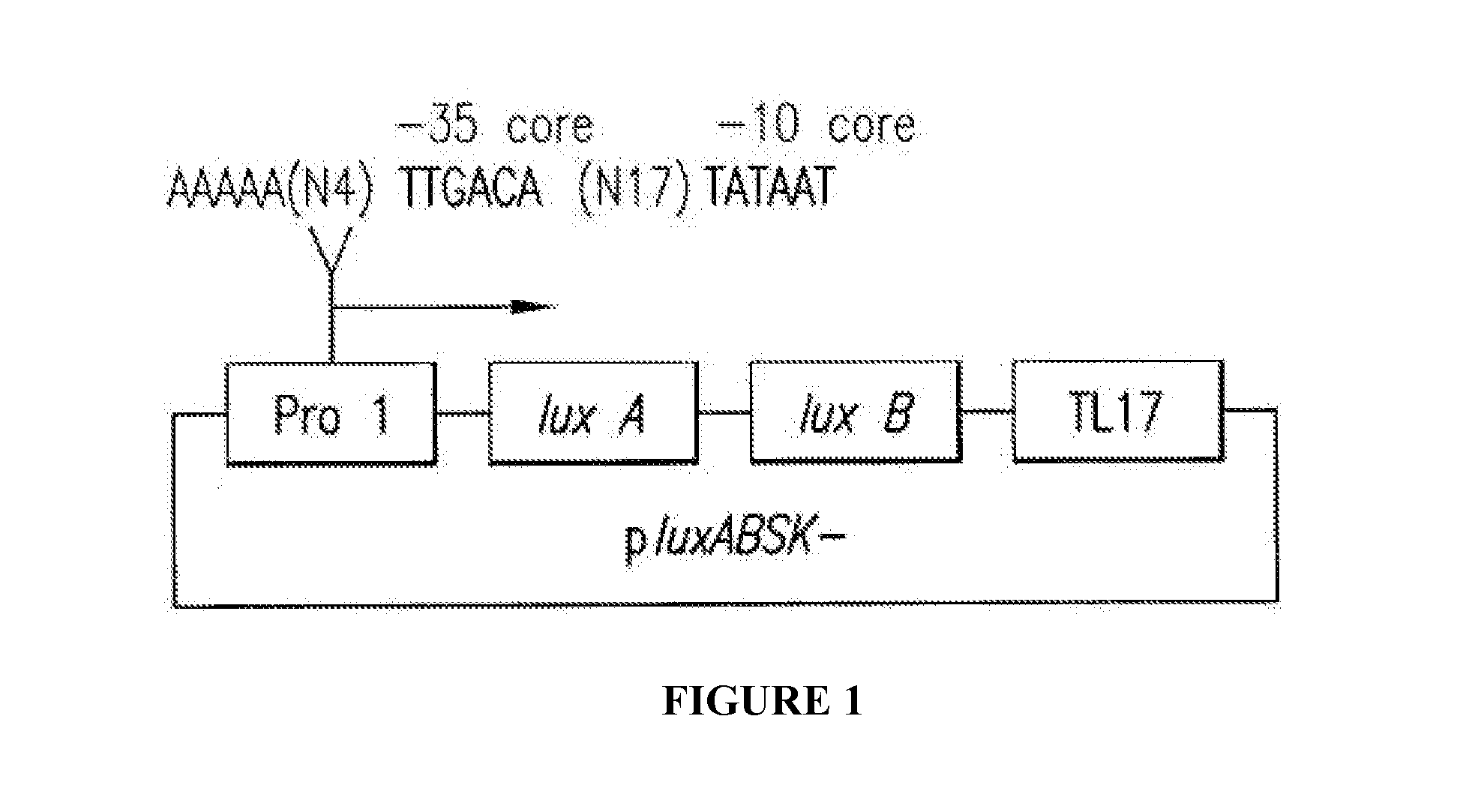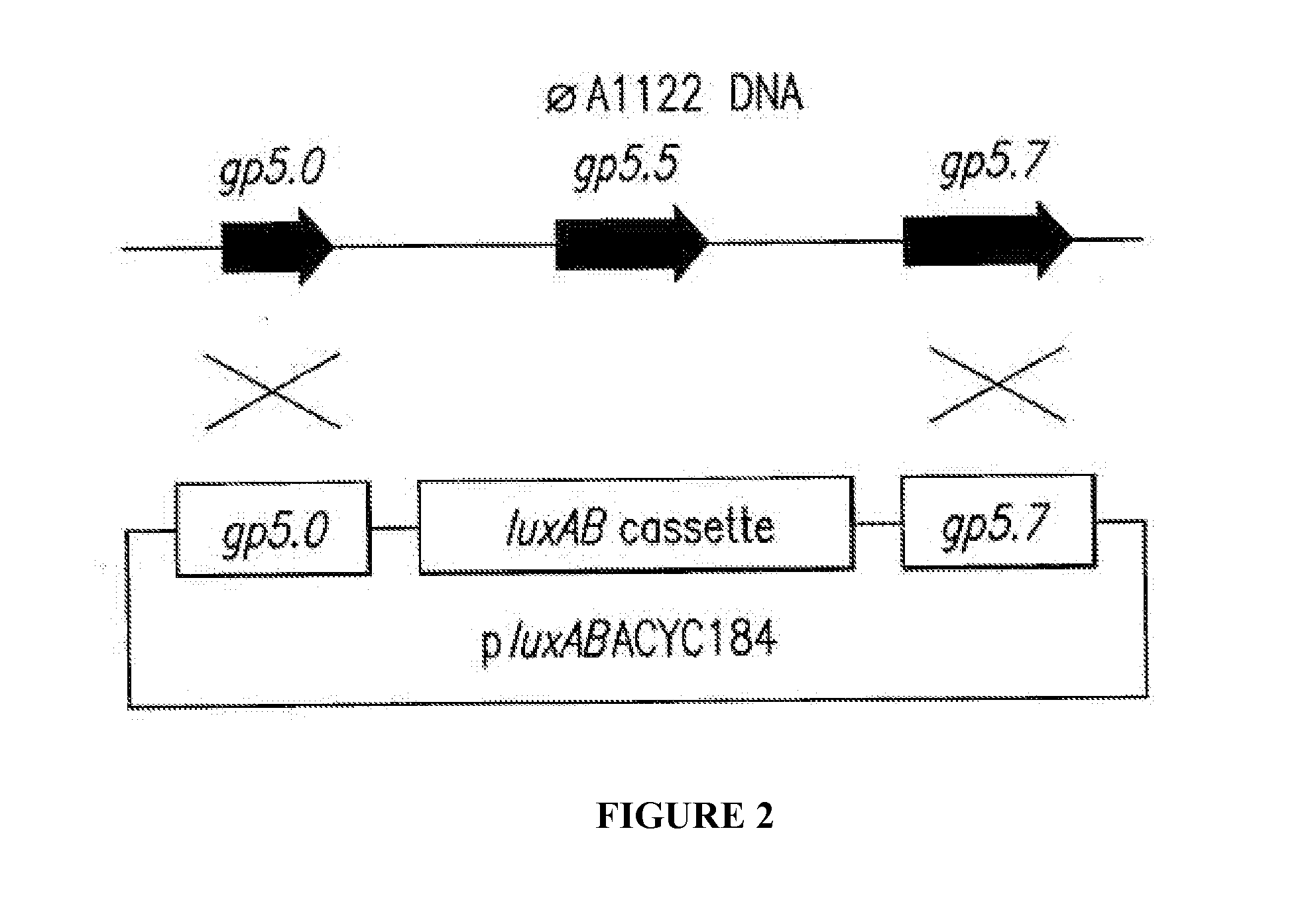Phage-Mediated Bioluminescent Detection of Yersinia Pestis
a technology of yersinia pestis and bioluminescence, which is applied in the field of phage-mediated bioluminescence detection of yersinia pestis, can solve the problems of pneumonic plague almost always fatal, sporadic plague outbreaks, and deliberate release of i>y. pestis /i>,
- Summary
- Abstract
- Description
- Claims
- Application Information
AI Technical Summary
Benefits of technology
Problems solved by technology
Method used
Image
Examples
example 1
Y. pestis Strain and Phage Propagation
[0064]Y. pestis specific diagnostic phage φA1122 may be obtained from the CDC. The attenuated Y. pestis A1122 strain may be obtained from BeiResources (Bei#NR15, NIH / ATCC Biodefense and Emerging Infections Research Resources Depository). The Y. pestis A1122 strain is an excluded select agent strain which lacks the 75 kb low-calcium response (Lcr) virulence plasmid, and is thus irreversibly attenuated. A similar Lcr negative strain (Tjiwidej S) has been routinely used as a live vaccine in humans in Java indicating that the strain poses little to no threat to public health. Nevertheless, experiments involving Y. pestis A1122 may be performed under BSL2 conditions as recommended by BeiResources. Y. pestis A1122 may be grown on brain heart infusion (BHI) agar and liquid broth at 30° C. Clonal stocks of φA1122 phage may be prepared from single plaques. Y. pestis A1122 may be prepared by growing the cells in BHI media at 30° C. until an OD600 of 0.6 i...
example 2
Construction and Design of a luxAB Expression Cassette
[0066]LuxA and luxB may be PCR-amplified using the proofreading thermostable enzyme PfuUltra (Stratagene) and pQF110 (ATCC77113, contains luxAB) as template. The PCR primers may be designed to contain restriction endoculease sites for directional cloning into the corresponding sites of pBluescriptSK− (Stratagene). The 5′ primers may contain a consensus ribosome binding site (TAAGGAGGTAAAAAA(ATG)) (SEQ. ID. NO: 1) which has been shown to mediate efficient translation initiation in Gram-negative Enterobacteriaceae species. The luxA and luxB may be sequentially cloned into pBluescriptSK− (to create pluxABSK−) by standard cloning methodology, and transformed into the propagating strain E. coli ER2738. Diagnostic restriction endonuclease analysis and agarose gel electrophoresis may be used to verify that the correct clone has been selected. The sequence of the PCR-amplified luxA and luxB genes may be verified by deoxy dye terminator s...
example 3
Generation of the φA1122 Targeting Vector for Homologous Recombination
[0068]The φA1122 phage has recently been sequenced (GenBank Accession No. AY247822 and GenBank Accession No. NC—004777), making genetic manipulation of the phage more readily achievable. The phage genome consists of 37,555 bp, with 51 predicted gene products originating from 46 distinct open reading frames. The φA1122 phage is very closely related to the coliphage T7 (and to a lesser extent T3) sharing a nucleotide identity of about 89%. A strategy involving direct cloning of the luxAB cassette into the φA1122 genome may not be pursued since the genome is large (˜37 kb) making cloning difficult, and because it lacks appropriate restriction endonuclease sites. Therefore, the luxAB cassette may be integrated into the φA1122 phage genome by homologous recombination based on a double cross over event. The luxAB cassette may be targeted for integration at two different sites in the phage genome using two slightly diffe...
PUM
| Property | Measurement | Unit |
|---|---|---|
| temperature | aaaaa | aaaaa |
| temperatures | aaaaa | aaaaa |
| temperatures | aaaaa | aaaaa |
Abstract
Description
Claims
Application Information
 Login to View More
Login to View More - R&D
- Intellectual Property
- Life Sciences
- Materials
- Tech Scout
- Unparalleled Data Quality
- Higher Quality Content
- 60% Fewer Hallucinations
Browse by: Latest US Patents, China's latest patents, Technical Efficacy Thesaurus, Application Domain, Technology Topic, Popular Technical Reports.
© 2025 PatSnap. All rights reserved.Legal|Privacy policy|Modern Slavery Act Transparency Statement|Sitemap|About US| Contact US: help@patsnap.com



